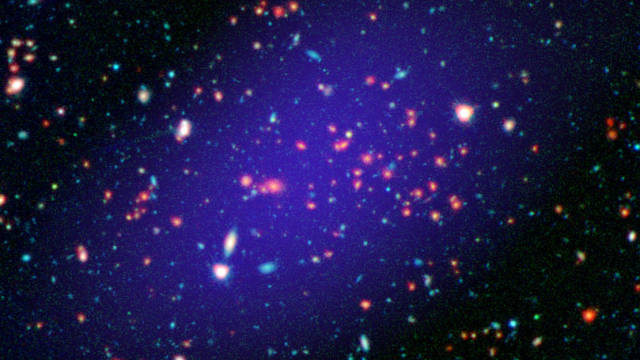Astronomers have discovered a giant gathering of galaxies located 8.5 billion light-years away, is the most massive structure yet found at such great distances.
The galaxy cluster observed thanks to NASA’s Spitzer Space Telescope and Wide-field Infrared Survey Explorer (WISE).
Above: The galaxy cluster called MOO J1142+1527 can be seen here as it existed when light left it 8.5 billion years ago. The red galaxies at the center of the image make up the heart of the galaxy cluster. Image credit: NASA/JPL-Caltech/Gemini/CARMA
Galaxy clusters are gravitationally bound groups of thousands of galaxies, which themselves each contain hundreds of billions of stars. The clusters grow bigger and bigger over time as they acquire new members.
How did these clusters evolve over time? What did they look like billions of years ago? To answer these questions, astronomers look back in time to our youthful universe. Because light takes time to reach us, we can see very distant objects as they were in the past. For example, we are seeing the newfound galaxy cluster — called Massive Overdense Object (MOO) J1142+1527 — as it existed 8.5 billion years ago, long before Earth formed.
As light from remote galaxies makes its way to us, it becomes stretched to longer, infrared wavelengths by the expansion of space. That’s where WISE and Spitzer help out.
For infrared space telescopes, picking out distant galaxies is like plucking ripe cherries from a cherry tree. In the infrared images produced by Spitzer, these distant galaxies stand out as red dots, while closer galaxies look white. Astronomers first combed through the WISE catalog to find candidates for clusters of distant galaxies. WISE catalogued hundreds of millions of objects in images taken over the entire sky from 2010 to 2011.
They then used Spitzer to narrow in on 200 of the most interesting objects, in a project named the “Massive and Distant Clusters of WISE Survey,” or MaDCoWS. Spitzer doesn’t observe the whole sky like WISE, but can see more detail.
Anthony Gonzalez of the University of Florida in Gainesville, lead author of a new study published in the Astrophysical Journal Letters, said:
“It’s the combination of Spitzer and WISE that lets us go from a quarter billion objects down to the most massive galaxy clusters in the sky.”
source jpl.nasa






Leave A Comment